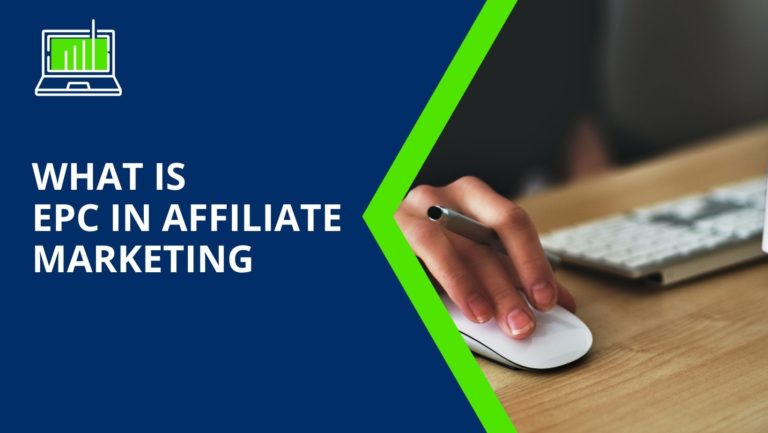When it comes to affiliate marketing, acronyms are often just as confusing as the lingo. So, what does EPC in affiliate marketing stand for? EPC stands for “earnings per click” and this metric is often used when referring to advertising performance. In affiliate marketing, however, EPC is used to refer to the earnings per click, on affiliate links, a publisher makes when they send visitors to an affiliate partner’s website.
This makes EPC an important metric that measures the performance of different traffic sources or an affiliate marketing campaign.
It’s a simple concept: If a publisher sends 100 visitors to an advertiser’s website and makes $100, their EPC is $1.00. If they send 100 visitors and make $50, their EPC is only half of that at $0.50. EPC is also sometimes used to refer to conversion rate. In some cases, the EPC can be viewed as a ratio of total visitor earnings divided by total visitor traffic sent.
How is EPC Calculated?
To calculate EPC, you need to know one thing: what you are selling. A number of things factor into calculating the EPC of your offer, including clicks and conversions. To define EPC in affiliate marketing you only have to use the following formula for calculating EPC:
EPC = Revenue / Clicks
Or if you want to calculate your EPC as a percentage:
EPC% = Revenue / Clicks * 100
You also need to know your revenue and the number of clicks you sent to. So, to calculate EPC, you need to send visitors to the advertiser’s website (Clicks) and then record the amount paid by the advertiser (Revenue). Thus EPC provides an important metric that can be used to calculate the total commission an affiliate receives from his affiliate marketing activities. This means the EPC is essential in calculating the affiliate marketing revenue and affiliate marketing earnings for an affiliate marketer.
Why EPC Marketing is important in affiliate marketing?
There are many benefits to know your EPC (earning per click) in affiliate marketing, some of which are listed below. The goal of each affiliate marketer should be to get a high epc in order to earn much money.
1. It helps affiliate marketers understand their online advertising performance.
EPC can help advertisers find the best affiliate offer in their niche and can help them increase conversion rates. This means more customers and higher sales. EPC can also help affiliates find the best converting offers. With an EPC, affiliates can see what offers are converting well and which ones aren’t. Then, they can try new things (such as making changes to the landing page or writing more enticing ad copy) to increase their earnings.
If the performance thus they have lower epcs, it might makes sense to start A/B testing their affiliate campaigns to find which advertising campaign leads to more clicks on their affiliate link.
2. It helps affiliates understand their performance and find the best offers to promote.
Knowing your EPC is key in affiliate marketing because it can help you find the best affiliate product to promote and the best affiliate partner to work with. It can also help you find the best publishers to work with and which offers to promote in your email newsletter to clients. By promoting offers that convert, you’ll have higher conversion rates.
3. It helps publishers find the best advertisers to work with.
EPC also can help affiliate marketers to find the ideal advertisers to partner with. The higher the EPC, the more attractive the advertiser will appear in rankings. A affiliates that promote your product on their website with a low epc mean that their traffic is not the best fit for the product. Thus EPC helps publishers to rate new affiliates by a common metric.
4. It can help advertisers and publishers increase the amount they are paid.
By understanding EPC and being able to calculate it, you can use this information to negotiate better commission rates or higher payouts. Making these calculations will help you negotiate better rates and get paid more for your efforts that you promote in a blog post.
5. It helps publishers sell more products or services to advertisers.
The higher the EPC, the more likely that advertiser is to purchase additional advertising from the affiliate. So, estimating a higher EPC can also help publishers sell more advertising to advertisers.
6. It helps affiliate marketers to select the best affiliate partner from a list of affiliate partners.
As an affiliate marketer you are able to select the affiliate partners to work with from a huge list. The quality of the landing pages and sales page varies a lot and thus the conversion rates are very different. One of the key KPIs to select a high converting offer from an affiliate partner can be earnings per click. It shows the amount of money the affiliate marketer can make per click on the offer.
Comparing different digital marketing metrics
EPC vs. CPA
If you are advertising on a website, EPC is often used interchangeably with CPA. The difference between the two lies in what’s being measured. EPC is about revenue earned per click and CPA is about the cost of an advertising campaign (Clicks – Cost). We talk about EPC versus CPA later on in this article.
EPC vs Conversion Rate
An EPC is sometimes used as a conversion rate. When you say a conversion rate is the “percentage of visitors that convert,” you are referring to EPC.
For example, if you have an advertiser with an EPC of $2.00 and your EPC is 40% (say, you have a 4000 clicks/day campaign), then it’s probable that between 40% and 60% of your visitors will convert (or earn revenue) for the advertiser.
Again, remember that EPC is a ratio and conversion rate is a percentage. To calculate the EPC as a percentage, you must express it as a decimal and divide it by 100.
EPC vs CPC
CPC (cost per click) is calculated the same way as an EPC in most cases. The difference between the two lies in what you are selling and what you are being paid for each click. If you run an affiliate program, then your CPC might be measured differently than an advertiser’s CPC. If you are running a PPC (pay per click) campaign, your CPC is calculated differently than the advertiser’s.
For example, let’s say an advertiser has an EPC of $2.00 and your EPC is 40% (say, you have a 4000 clicks/day campaign). The average cost for a click for the advertiser during this period is $1.00. So, the CPC is $2.00 * 100 / 4000 = $0.20.
If the same advertiser has an EPC of $2.00 and your EPC is 40%, their average CPC is $1.80. So, their total CPC = $2 * 0.4 * 100 / 4000 = $0.20.
One final note: EPCs can be calculated with a variety of methods, including Google Analytics and CrazyEgg’s CPA pricing engine. However, Google Analytics and CrazyEgg’s EPC calculation method are slightly different.
How to improve your earning per click(EPC)?
If your EPC is too low, you may be missing out on high-paying advertisers and deals. If you are getting lower than average EPCs, there are several things you can do to improve them.
1. Consider a variety of offers (not just one) to post on your site.
It’s possible that one offer isn’t converting as well as another in a different niche or vertical. If that’s the case, you should try promoting a different offer to see how it will impact EPC. You also need to experiment with different offers to find the best one. Offering the right mixture of addiliate products from different affiliate marketing networks can earn you a lot of money.
2. Increase your conversion rate.
Improve the quality of the offers you send out to visitors by providing useful, compelling (click-worthy) content and increate the total clicks on your referral links.. Create great product pages that customers will be excited to read and learn more about your products. If a visitor doesn’t understand why they should buy your product, maybe they don’t need it in the first place and you’re wasting their time on a lackluster website!
3. Improve the quality of offers you post on other affiliate sites and find affiliates who are using poor offers.
Using poor offers is a recipe for low EPC. If you use poor offers and they don’t convert, they won’t pay you your commission. You can find out if the other advertisers are using low quality offers by performing your own CPA analysis (CPC analysis). If you find that some affiliates are using lower quality offers, then ask them why and improve the offer to higher quality products to get better conversion rates.
4. Calculate the cost per thousand (CPM) of your landing pages or product pages.
Landing pages and product pages that cost more to make (and a lot more to acquire) will be easier for visitors to convert. For example, if it costs $1.00 to acquire an ad with a clickthrough rate of 1%, then the same landing page or product page with a CPM of $2.00 will have a clickthrough rate of 2%.
5. Improve your ranking in the search engines by writing unique, high quality content and offering links to high value websites and products.
If you want to get higher paying clicks from high quality advertisers, then do what it takes to earn higher quality links from high value websites (like Google and Bing). The better your website ranks in the search engines for other keywords and phrases, the more traffic (and better per click offers) you will be able to attract.
6. Establish a good reputation with advertisers by working hard on delivering their product(s) to customers.
After you make your purchase, many advertisers will send you emails asking if you have received the product or not. You should respond to these emails promptly to show that you are in fact receiving the product or have a positive experience. Providing good customer service will also help improve your reputation with advertisers.
7. Find the best publishers in your niche or vertical for your traffic source.
When you are working with affiliate networks or publishers, you want to post offers from publishers who have an excellent reputation and can only send high-quality traffic to advertisers. If you choose affiliates or publishers with a bad reputation for sending spam traffic, you will be spending more time working with low-quality traffic that doesn’t convert!
8. Build better relationships with your advertisers.
If you are working with advertisers, then having a good relationship is important and can help your earnings per click go higher. Have regular, direct conversations (phone calls and emails) about their campaigns so that your relationship can improve over time.
9. Email List
another way to increate the average epc is to promote additional affiliate marketing offers through an email newsletter. This simple way can increase your affiliate commission and earning potential. Many successful affiliate marketers increase their average earnings per click by sending email newsletters to their email list.
Conclusion
As we discussed earlier, EPC is a relative metric that can help you determine the quality of an affiliate program and your performance within it. If your EPC is very low compared to other advertisers, you may not be matching the quality of your competition. It’s important to improve your earnings per click by analyzing what works and doesn’t work in your affiliate marketing campaigns so that you can make smart decisions in both short-term and long-term projects.


